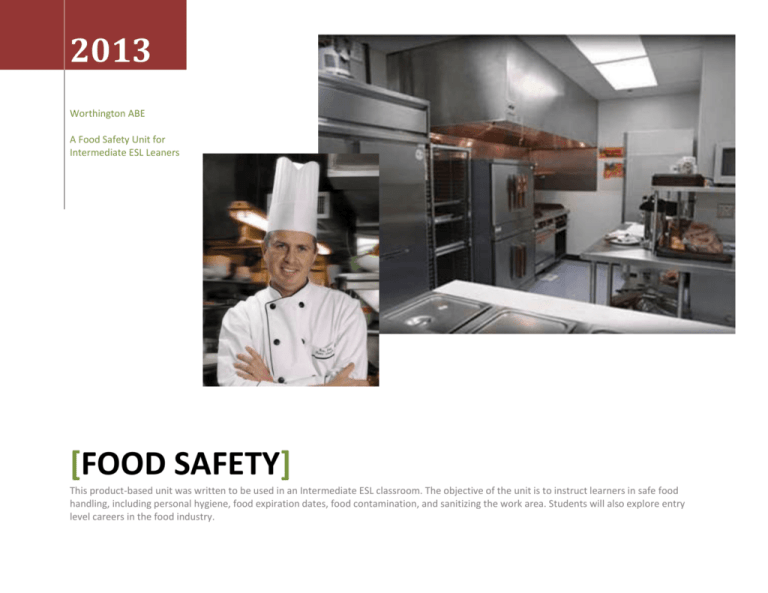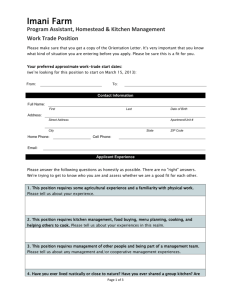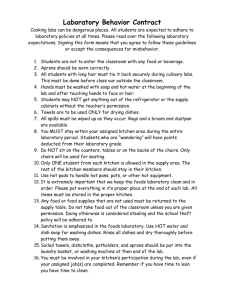Activity Plan and Teacher`s Notes
advertisement

2013 Worthington ABE A Food Safety Unit for Intermediate ESL Leaners [FOOD SAFETY] This product-based unit was written to be used in an Intermediate ESL classroom. The objective of the unit is to instruct learners in safe food handling, including personal hygiene, food expiration dates, food contamination, and sanitizing the work area. Students will also explore entry level careers in the food industry. Food Safety Worthington ABE – 2013 Page 1 Food Safety Timeline Section Section Product 1 6-8 Hours Write guidelines for personal hygiene in the kitchen Materials Materials AP-1: Video – Hand washing (5:45 minutes) http://www.youtube.com/watch?v=qagmw3oGOVg AP-1.1: Handout “Hand washing Fact Sheet” http://www1.extension.umn.edu/foodsafety/sanitation/handwashing-for-kids.pdf AP-1.1a: Worksheet “Hand washing Facts” AP-2.1: Activity – Hand washing Order Race AP-2.2: Handout – Hand washing checklist AP-3.1: Handout “Kitchen Attire” AP-3.2: Game – Kitchen Attire (teacher’s notes) Activity Product 1 Activity Activity Product 2 Activity Activity Product 3 Identify the reasons why proper handwashing is important Identify and evaluate each other’s hand washing via a checklist Identify proper kitchen attire Activity Product 4 Kitchen hygiene guidelines Teacher Notes: AP-1: Show the video. Ask students to note the points of contamination – discuss meaning of contamination. (Sick person to hands, hands to clean sheets, sheets to another employee, hands to doctor and stethoscope, stethoscope to another patient, hands to hair, hair to hands – recontamination, hands to soap dispenser and faucet, hands to baby bed, hands to purse to security guard, hands to child and mother) Discuss: What is the best way to avoid passing germs? (Hand washing) AP-1.1: Hand out the Hand washing Fact Sheet and Worksheet – Read, discuss and answer questions. AP-1.1a: This is an alternate activity for introducing hand washing. It can be used for lower level classes. AP-2.1: Print out Hand washing Steps and cut apart (one set for each team). Divide class into teams. Teams must race to see who can get the hand washing steps in proper order first. AP-2.2: Students work together to check each other’s hand washing technique AP-3.1: Have students work together in small groups to discuss proper kitchen attire. Review and share as a large group. AP-3.2: Play the Kitchen Attire game (description in file) AP-4: Divide the class into small groups. Tell them they are a committee whose task is to write guidelines for proper personal hygiene in the kitchen of their place of business. They can decide what business they are representing, and then write out a list of guidelines, and make a poster to be presented to the rest of the class. AP-4.1: Note that the focus of Easy at Work is to present information and activities about dishwashing and sequencing the steps. Worthington ABE – 2013 Page 2 Food Safety Product 2 6-8 hours Demonstrate knowledge of safe food selection, handling, and expiration dates AP-1 Video: “How to Tell if Food Has Gone Bad” (1:22) http://www.howcast.com/videos/357110-How-to-Tell-IfFood-Has-Gone-Bad A P-1.1: Worksheet “How to Tell if Food Has Gone Bad” AP-2: Food Labeling PPT AP-2.1: Food Labeling Identification Activity AP-3: Video – “How to Avoid Food Poisoning: Bacteria” (3:22) https://www.youtube.com/watch?v=Mwe2-sTDKBw AP-3.1: Worksheet “How to Avoid Food Poisoning: Bacteria” AP-4: Video – “How to Prevent Food Poisoning” (1.56) http://www.youtube.com/watch?v=DizdkUayQBw AP-4.1 Worksheet “How to Prevent Food Poisoning” AP-5: “Eating Well, Living Well” Unit 6-Low Intermediate http://eatingwell.ca5aday.com/lessons.asp AP-6: Assessment Product 1 Product 2 Product 3 Recognize signs of food that should not be eaten Identify the meaning of expiration date labels Understand what food poisoning is and how it happens Activity Product 4 Activity Product 5 Activity Product 6 Understand how to prevent food poisoning Identify food contamination sources Demonstrate understanding of appropriate food handling in a commercial kitchen Teacher Notes: AP-1: Prior to showing the video, hand out the worksheet (AP-1.1) and explain that students should fill in the missing words as they watch and listen to the video. Tell the students you will watch the video more than one time. Show the video a couple of times, and then ask the students to help fill in the missing words. If there are still words that no one has gotten, watch again. Discuss. Read through the vocabulary words, and then allow students to work through the Vocabulary activity in pairs. Review together. AP-2: Show the PowerPoint and discuss as you go through the slides. To check understanding of reading expiration dates, bring in a variety of items that display expiration dates. Students should practice reading the dates, paying careful attention to whether the date is “Month-Day” or “Day-Month”. AP-2.1: Use this handout as an assessment for reading expiration dates. AP-3: Ask students what they know about food poisoning. Create a KWL chart on the board (“What do you know?” “What do you want to know?” “What did you learn?”) After discussion, hand out the worksheet (AP-3.1), go over the sentences, and then show the video. Tell students to underline words that make the sentences false, and write the correct word. AP-4: Go back to the KWL chart that you created for AP-3. Ask if some of the “What do you want to know?” questions have been answered. Fill in “What did you learn?” where possible. There may still be unanswered questions. Use the video and worksheet to help clarify. Go back one more time to the KWL chart to see if questions have been answered and discuss. AP-5: Follow the instructions and use worksheets from Unit 6 – Low Intermediate, of the “Eating Well, Living Well” curriculum. AP-6: Use the story to assess the students understanding of the concepts covered so far in the unit. Worthington ABE – 2013 Page 3 Food Safety Timeline Section Product 3 Write a plan for cleaning/ sanitizing a kitchen Materials Activity Product 1 Activity Product 2 Activity Product 3 AP-1.1: Video “How to Clean and Sanitize the Kitchen” (1:56) http://www.youtube.com/watch?v=cv15rRuIGvY AP-1.1: Worksheet “How to Clean and Sanitize the Kitchen” AP-1.2 Video “Sanitizing a Kitchen” (2:56) http://www.youtube.com/watch?v=_9IhS2jv2OM AP-1.2 Worksheet “Sanitizing a Kitchen” AP-2: Chart to evaluate cleaning products AP-3: Sanitizing solution product assembly AP-4: Easy @ Work Unit 4 Lesson 2 DVD AP-4: Easy @ Work Unit 4 Lesson 2 handout AP-4.2: PDF – “Manual Dishwashing Procedure” AP-5.1: Picture – “Preparing Food Safely” AP-5.2: Kitchen Evaluation Checklist AP-6: Conversation Chart Explain the difference between “clean” and “sanitized” Evaluate cleaning products Make a sanitizing product Activity Product 4 Activity Product 5 Activity Product 6 Sequencing steps of dishwashing Observe a restaurant kitchen and evaluate sanitization procedures Conversation Chart Teacher Notes: AP-1.1: Go through the vocabulary words with students. Have them do the matching exercise. Watch video http://www.youtube.com/watch?v=cv15rRuIGvY (1 minute 56 seconds). Talk about the vocabulary words and how they connected with the video. Begin the “Fill in the Blanks” exercise. Give the students about 10 minutes to try to complete, then watch video again. See if they are then able to complete then correct together as a large group. AP-1.1.5: Worksheet on what students and teachers need to have available for this project and a list of instructions on making the products. AP-1.2: Go through the vocabulary words with students. Have them do the matching exercise. Watch video http://www.youtube.com/watch?v=_9IhS2jv2OM (2 minutes 16 seconds time for video) Talk about the vocabulary words and how they connected with the video. Begin the “Fill in the Blanks” exercise. Give the students about 10 minutes to try to complete, then watch video again. See if they are then able to complete then correct together as a large group. AP-2: Bring in different bottles of cleaning products to clean a kitchen. The students could also bring a favorite cleaning product. Look at the label on the cleaning product and write in the name, approximate cost, directions, and warnings on the chart. Students compare the different products in groups and decide if they are safe to use or not, and if they would use the product or not. Finally, discuss preferences for “storebought” or “homemade” products. Students should cite reasons for their choices. AP-3: Divide students into small groups to make one of the sanitizing solutions. Discuss the questions at the end of the AP-3instructions page. AP-4.1: If you have access to the “Easy @ Work” series, they have some great videos on kitchen jobs. The focus of the “Easy @ Work” series is to present information and activities about dishwashing and sequencing the steps. AP-4.2: Manual Dishwashing Procedure Photo-Make copies to hand out to students for worksheet (AP-4.3) AP-4.3: Have students complete worksheet and discuss with partners. Worthington ABE – 2013 Page 4 Food Safety AP-5.1: Show students kitchen photo to evaluate with checklist AP-5.2. AP-5.2: Visit a restaurant kitchen or a friend’s kitchen and evaluate for cleanliness and sanitary conditions. Do you see any sanitation violations? Before visiting the kitchen, rate the importance of the listed areas: most important – 1; important – 2; less important – 3; or not important – 4. Then check the kitchen areas that are meeting the cleanliness standards. If these standards are not observable write N/A at the end of the sentence. Ask students to bring their evaluation sheets back to class and share what they learned. AP-6: Have students discuss the questions on the conversation chart in pairs. AP-7: Additional resources for videos to use for kitchen sanitizing and cleaning. Worthington ABE – 2013 Page 5 Food Safety Timeline Section Product 4 9 hours Complete an internet search and answer a question sheet for the student’s chosen kitchen career Materials AP-1: Exploring Careers on iseek.org in computer lab AP-1.1: Worksheet “Career Exploration” AP-2: Career Videos and Question Sheets AP-3: Career Interview Questions AP-4: Kitchen Career Exploration Grid Activity Product 1 Activity Product 2 Activity Product 3 www.iseek.org instruction sheet & Question Sheet Career Videos and Question sheets Career Interview Questions Activity Product 4 Kitchen Career Exploration Grid Teacher Notes: AP-1: Have students look at instructions sheet. Pre-teach in classroom computer skills in logging onto iseek and what they are supposed to do there. Go through instructions at least 2-3 times for clear understanding of what they need to do at the computer lab. Have students use instruction sheet in computer lab. Use Question Sheet AP-1.1. AP-2: Have students look at career videos and question sheet. Explain that they will be looking at the careers on the website. Pre-teach going to the website and looking at the videos and careers. Do one together as a class, then, have students go into the computer lab and look up careers and answer the “Career Questions” below the instructions. Can use AP1.5 instead, if too challenging. AP-3: Present the Interview Questions to the students. Go through any vocabulary that may be questionable. Practice asking and answering questions with a partner. Then instruct students to find someone they know who isn’t in their class who has a job in the hospitality field and interview them. AP-4: Present the Grid to the students. Remind them of the places on the internet that they have previously explored and have them initiate this last exploration for two kitchen careers. Have them go through the grid in class to make sure they understand the project and then have them go into the computer lab to search for careers and completion. Worthington ABE – 2013 Page 6 Food Safety Timeline Section Product 4 2 hours Final Product— Preparing a Fruit Salad following food safety rules with evaluation by classroom audience Materials AP-1: PowerPoint “Recipe Vocabulary” AP-2: Worksheet “Recipe Vocabulary” AP-3: Fruit Salad Recipe AP-4: Checklist for Salad Preparation Activity Product 1 Activity Product 2 Activity Product 3 Power point for recipe vocabulary Recipe Vocabulary Match Fruit Salad Recipeprepare Activity Product 4 Checklist for Salad Prep Teacher Notes: AP-1: Go over Recipe Vocabulary ppt and talk about vocabulary. Hand out ½ sheets of paper (or recipe cards) with vocabulary words on them. Go through the ppt again and ask students to show the card if they see the picture of their vocabulary word on the board. Make sure that each student will have a card. Make duplicates if necessary. Go through it again after you’ve switched cards. AP-2: Have students do the recipe vocabulary match. AP-3: Hand out recipe for students to read with teacher to understand vocabulary and measurements. Make sure that the students understand the vocabulary on recipe. Have a group of students prepare the salad. Have the rest of the students evaluate with worksheet. AP-4: Go over checklist with students and make sure they understand the vocabulary and how to evaluate and respond. Worthington ABE – 2013 Page 7






